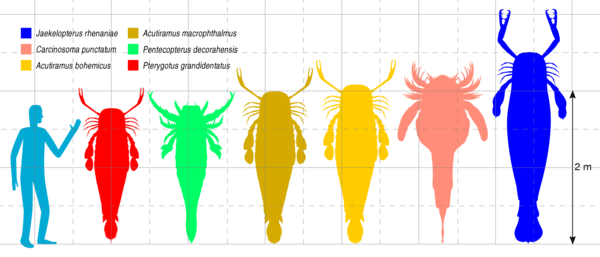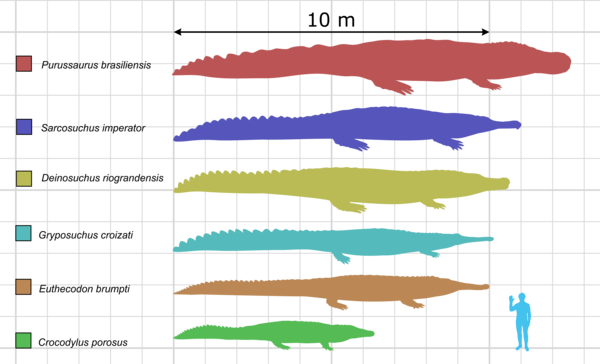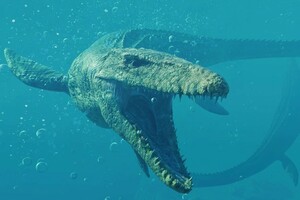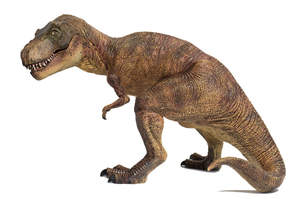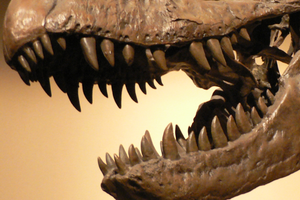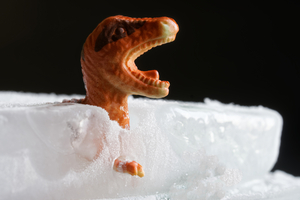The Largest Prehistoric Animals
One thing that constantly fascinates human beings about animals in general is their size. From huge rhinos to giant elephants and towering giraffes, human beings are enamored with massive megafauna. But most of the largest animals that have ever lived are now extinct, known only from the fossil record. Many dinosaurs that scientists consider “medium-sized” approach the “giant” sizes we attribute to much of today’s megafauna. Indeed, size itself is a relative concept. In the modern world, relative to much of the rest of the animal kingdom, human beings themselves are inordinately large animals, with most primates being only about half of our average size.
But why did so many of the largest animals that have ever lived go extinct? Why do the largest mammals not reach the same sizes as the massive dinosaurs that preceded them? And of every animal to ever live, which one holds the crown for most massive of all? Many adaptations and evolutionary trends dictate size. Large sizes can be particularly advantageous, a large animal will have little in the way of predators, and can control a larger territory with little effort compared to its smaller contemporaries. Large predators can subdue prey with their bulk and stride farther than smaller ones. But size can also be a limiting factor. Large mammals can’t reach the same sizes as the titan dinosaurs because they push comparatively more energy into carrying and gestating their offspring than reptiles. Large animals have a harder time changing their internal body temperature, and are often subject to small parasites that they have difficulty ridding themselves of. It also takes much longer for huge animals to reach their adult size, and when a major anti-predation adaptation is size, it can be dangerous and difficult for the young of such creatures to survive without supervision. For other animals, respiration and nutrition become issues. Larger animals need more oxygen than smaller animals, and need to eat much more to maintain homeostasis. Giant arthropods of the past would possibly have difficulty breathing in today’s atmosphere, with the slightly lower concentration of oxygen in the air today than in the past, although some periods with lower oxygen concentration than today still had giant arthropods, so this is not definitely known. Huge amphibians would face similar problems, their lack of robust lungs and reliance on their skin for respiration would make it difficult for them to oxygenate all of their tissues while also retaining moisture. Big predators would need to prey upon larger and more dangerous prey animals, while big herbivores would need to eat their own weight in foliage to stay alive.
Regardless of the pros and cons, many animals in Earth’s prehistory became quite large, becoming some of the largest megafauna to ever live. Massive fish, reptiles, proto-mammals and amphibians all reached huge sizes before the first small dinosaurs even began to eke out their niches. Even after they had died out, the mammals swiftly filled the open niches of the giant dinosaurs, with massive extinct elephants like Palaeoloxodon or the giant long-necked rhinoceros, Paraceratherium. Herein lies just a sample of some of the most well known of the ancient giants, some of the largest organisms to ever walk, swim, or fly on planet Earth.
The largest dinosaur known from reasonably well preserved remains is the enormous sauropod, Argentinosaurus huinculensis. Argentinosaurus was a huge long-necked herbivore, reaching approximately 100-115 feet (30-36m) in length, 60 feet (18m) in height, and weighing an estimated 65-90 tons. It would have lived alongside smaller sauropods, mid-to-small sized abelisaurid carnivores like Skorpiovenator, and the 40 foot carnivore (12.5m) Mapusaurus, a member of the carcharodontosaur family of theropods. This being said, large adult sauropod dinosaurs are hard to measure due to the frequently partial state of their fossilized remains. Some groups, like the diplodocids, had long, thin tails that preserve poorly. They were also quite large, so preservation by normal means before any large predators were able to scavenge the carcass and perhaps destroy parts of the skeleton would be unlikely. Still, several well-preserved sauropod remains have been found, and from their proportions scientists can make reasonable estimates of fragmentary and partial remains.

A mounted skeleton of Argentinosaurus at the Fernbank Museum of Natural History next to a skeloton of Giganotosaurus. Photo credit Steve Harwood
Some remains of more partial and fragmented sauropod dinosaurs may have exceeded Argentinosaurus in length, however it is difficult to say for certain. Maraapunisaurus fragillimus, formerly known as “Amphicoelias” may have been larger, however only one specimen, a damaged vertebrae and femur, has ever been found, and it has since been lost to scientists. By comparing records of the size of said bones to other sauropods, a rough estimate can be made of the animal’s size, with many estimates exceeding Argentinosaurus. However, because the remains are not physically accessible, these estimates cannot be verified.
The largest theropod dinosaur by length is easily the uniquely adapted semi-aquatic Spinosaurus aegypticus. Reaching approximately 50-52 feet (15-16m) in length, it surpassed both Tyrannosaurus rex and the large carcharodontosaurs like Giganotosaurus carolinii by nearly a full 10 feet (3.2m). This north African sail-backed dinosaur probably lived a semi-aquatic lifestyle, sporting a paddle-like tail, a head with many adaptations suited for fish-snatching, and dense bones allowing it to submerge more effectively. The question of which theropod has more mass is a bit more complicated. Spinosaurus is likely the more massive theropod, however it is only known from a collection of partial remains, making weight estimates variable and difficult to make. Recent discoveries also show that Spinosaurus had denser-than-average bones, which may have made it bulkier than the other contenders. Tyrannosaurus rex is known from many, many different specimens, from every life stage. Large adult tyrannosaurs such as the “Scotty” or “Sue” specimens weighed 9-10 tons, while the average across most adult specimens was closer to 7-8 tons. Giganotosaurus, which exceeded Tyrannosaurus in length but is only known from one set of partial remains, has multiple weight estimates between 7.5 and 13.5 tons. It is difficult to say for certain which of these 3 is the more massive, but between the greater length and the multiple semi-aquatic adaptations, it seems likely that Spinosaurus wins the theropod size competition.
Some of the largest dinosaurs in other families were the most famous members of their respective groups. The largest ceratopsian was the 30 foot (9m), 8 ton Triceratops horridus, and the largest thyreophoran, or armored dinosaur, was Stegosaurus ungulatus, which was also 30 feet (9m), but lighter, at only around 8 tons. Shantungosaurus was the largest of the duck-billed hadrosaur ornithopods, bigger than Tyrannosaurus at 54 feet (16.5m) and 18 tons. And on the smaller end of the dinosaur family, the largest of the dromaeosaurs, or “raptor” dinosaurs, was the 16-22 foot (5-6m) Utahraptor, which may have been up to 1 ton in weight.
The Mesozoic era was the time on Earth when terrestrial life was at its very largest. Owing to a number of factors, the dinosaurs trended larger and larger in size, culminating in some of the largest vertebrates and largest reptiles to ever live. With lengths that surpassed 100 feet (32m), and weights that could have exceeded over 100 tons, the Titanosaurs were the very biggest of the long-necked sauropod dinosaurs. Other herbivores reached massive sizes as well, with Triceratops and Stegosaurus representing the ceratopsids and thyreophorans. The Ornithopod Shantungosaurus would have been the largest of the hadrosaur “duck-bill” dinosaurs. And as herbivores grew, so too would the carnivorous Theropods. Many large theropod dinosaurs exist, Tyrannosaurus being perhaps the most famous, however several others exist that match the tyrant king in size. Spinosaurus beats the king in length, while Giganotosaurus may have been heavier. These animals represent the pinnacle of size in land-dwelling animals.
Dinosaurs weren’t the only behemoths of the ancient world. Creatures both before, after, and during their reign reached comparable sizes, though none on land reached the same titanic proportions as the massive sauropods.
Pterosaurs dominated the mesozoic skies before the first birds came into being, and reached sizes that dwarf any bird, living or extinct. Of all the pterosaurs, however, it is the giant azhdarchid Quetzalcoatlus northropi which casts the largest shadow over its domain. With a wingspan nearing 40 feet (12.5m) and a standing height of 15-20 feet (5-6.5m), Quetzalcoatlus was not only easily the largest pterosaur, it was the largest flying animal in the history of planet Earth. It was a generalist carnivore, thought to have been equally comfortable striding and galloping on land as it would be in the air, stalking prey and carrion in late Cretaceous North America.
The sea has played host to a wealth of massive megafauna since the dawn of time. The Mesozoic era saw a bevy of reptilian regents vying for control of those tumultuous ancient oceans. The Triassic period saw the evolution of the ichthyosaurs, and among them, Shastasaurus sikanniensis rose as the largest of their kind. Not only that, but at 69 feet (23m) in length and nearly 75 tons, Shastasaurus was the largest known aquatic reptile to ever live. Shastasaurus was quite different looking compared to other ichthyosaurs, with a proportionately shorter snout and skinnier profile, giving it a more serpentine body shape. Some scientists believe that its shorter snout and smaller teeth were adaptations for soft-bodied prey like cephalopods, but this is contested.
Alas, the ichthyosaurs did not last through the Mesozoic, and the Jurassic and Cretaceous saw multiple new reptile groups take their place. Originating in the Triassic and flourishing in the Jurassic, the plesiosaurs will look familiar to any fan of the Loch Ness Monster. Of these long-necked reptilian carnivores, the biggest was Albertonectes vanderveldei, whose neck alone was 23 feet (7m) in length. In total, this Canadian fish-eater would have been similar in length to a grown T.rex, at about 38 feet (12m). But plesiosaurs came in two body morphs, the long-necked kinds like Albertonectes, and the short-necked varieties, called pliosaurs. The pliosaurs got even larger than the plesiosaurs, and of the larger varieties, Pliosaurus macromerus and Kronosaurus queenslandicus were neck-and-neck for the honor of largest pliosaur. Both reached a length of about 36-39 feet (11-12m) and around 12 tons in weight, and were thought to be fast, active predatory swimmers.
However, in the late Cretaceous, one last group of major reptilian rivals emerged. Descended from terrestrial monitor lizard relatives, the mosasaurs were also active marine predators with jaws full of round, pointed teeth for ambushing prey. The titular Mosasaurus hoffmanni was known to grow to similar sizes to the largest pliosaurs, reaching on average about 40-43 feet (12-13m) in length, and weight estimates vary from 4 tons for average sized individuals to 15 tons for possible larger specimens. Isolated remains, such as a quadrate bone from the skull which was measured to be about 150% the average size for an adult Mosasaurus, suggest that some individuals could have grown much larger, with estimates in the 55 foot (17-18m)/27 ton range, but substantial evidence for such individuals is not currently available.
The mainstays of the oceans and seas of the world will always be the fishes, however. During the mesozoic era, the gigantic filter-feeder Leedsichthys problematicus was the largest bony fish to ever live, at a staggering 35 feet (11.5m). Historically, this fish has been hard to measure, as a vertebral column has never been discovered. However, through comparison to related species and measurements of gill baskets, a variety of size estimates have been put forth. Most of these find consistency in the 30-40 foot range, though some exceptionally old specimens are believed to have reached the 52-54 foot (16m) range. Fastforwarding to the miocene, the largest shark to ever live was the famous Megalodon, known to scientists as Otodus megalodon. Reaching about 55 feet (16m) by most estimates, the Megalodon was a massive shark similar in appearance to modern mackerel sharks, which ate small whales in the warmer oceans of the prehistoric past. Its teeth alone could measure 5-7 inches (13-18cm), and as a shark, it would have had hundreds of them. Like Leedsichthys, Megalodon is quite difficult to measure; its cartilaginous skeleton does not preserve well. Scientists have made various estimates based on the size of its teeth, jaws, and scattered vertebrae. These estimates have ranged from 40 feet (12m) to over 100 (34m), however most lie consistently within the 50-65 foot (15-20m) range, with a weight of 14-37 tons for males, and 30-65 tons for females.

A large fossil Megalodon tooth compared to a large modern day Great White Shark tooth (white).
Yikes!
The largest known ammonite, Parapuzosia seppenradensis, had a shell with a diameter of about 5.5 feet (1.37m), and weighed almost 750 pounds. Parapuzosia was a desmoceratid, meaning that it was likely an active, predatory ammonite with an appetite for fish and other marine prey animals. It was likely fed on by large marine reptiles such as Mosasaurus, Globidens, and Tylosaurus.
Speaking of invertebrates, the largest arthropod ever was also a denizen of the waters, though this one likely swam in estuarine systems and not the open seas. At about 8.6 feet (2.7m) in length, Jaekelopterus rhenaniae was the largest known arthropod to ever live. This giant eurypterid “sea scorpion” was likely an ambush predator, leaping out from the bottom of the water column to attack and subdue prey with its huge, spiky claws.
Other arthropods reached enormous sizes throughout antiquity, such as the giant, 8 foot (2.5m) millipede Arthropleura armata. While just a hair shy of Jaekelopterus in terms of length, there was no other terrestrial arthropod that was a match for this animal. Because no fossilized mouthparts have been found, we cannot say for certain what Arthropleura’s diet was, but based on its relatives it was more likely to be an herbivore than a carnivore. In the air at roughly the same time was Meganeura, which was the largest flighted arthropod. This dragonfly-like insect reached nearly 1.3 feet (45cm) in length and about 2.5 feet (80cm) in wingspan, about the size of an adult human’s forearm. Going back even further, the giant trilobite Isotelus rex was the largest of these famous prehistoric bugs. With a face-plate that was 16 inches (41cm) wide and a total body length over 2 feet (71.1cm), this bottom feeder would have been well armored against any threats in the Ordovician oceans.
Moving back to land, though perhaps not completely, there is another branch of archosaurs that reached gigantic proportions in the prehistoric past. Sarcosuchus imperator, Deinosuchus riograndensis, and Purussaurus brasiliensis were giant crocodilians which each reached about 40 feet (12.5m) in length. Sarcosuchus and Deinosuchus lived in the Cretaceous period in Africa and North America, respectively, while Purussaurus lived in South America during the Miocene epoch. Of the three, Purussaurus was likely the heaviest, it had a broader, deeper snout meant for delivering devastating bite, meaning that its head and neck were likely more muscular and therefore heavier. Estimates place Purussaurus at 9.5 tons, Sarcosuchus at 8.8 tons, and Deinosuchus at 8.5 tons.
Keeping to the reptiles, next comes the contenders for biggest snakes and lizards! Technically speaking, the mosasaurs mentioned previously were the largest of all the squamates, but on land, the monitor Varanus priscus, of the same genus as the modern komodo dragon, reached a size of about 23 feet in length and was between 0.5-2 tons in weight. It was a major predator in pre-contact Australia, and it is thought that the first human arrivals on the continent over 50’000 years ago may have contributed to its extinction. The largest snake is much older, that being the 45 foot (14m) Paleocene boa, Titanoboa cerrejonensis. Titanoboa lived in Miocene South America, with a lifestyle similar to that of the modern day Anaconda. It weighed as much as 1.2 tons, and may have been adapted to a piscivorous diet, based on several unique adaptations of the skull which would have aided in underwater feeding and swallowing.
Living in a similar lifestyle to crocodilians, the largest amphibian to ever live was the temnospondyl Prionosuchus plummeri, which was convergently very similar to modern crocodilians. It reached a length of about 18 feet on average, but a singular specimen of 30 feet has been unearthed, far surpassing any other contenders for the largest amphibians. It lived during the Permian period, before the dinosaurs, and had a very fishlike internal physiology.
Most of the largest birds came after the extinction of the rest of the dinosaurs, and when it comes to birds, “biggest” can mean a lot of different things. The largest wingspan of 20-24 feet (6-7.5m) goes to the false-toothed giant seabird, Pelagornis, while the heaviest flying bird was the huge condor Argentavis, which weighed 160 pounds. The tallest bird was the flightless, herbivorous Giant Moa, Dinornis robustus of New Zealand, which went extinct only about 500 years ago, and was 12 feet (4m) tall. The heaviest bird ever was also a herbivorous ratite, Vorombe titan, from Madagascar. Though only 10 feet tall, it weighed over 1400 pounds at full size, compared to the Moa which only reached about 800-1100 pounds. The largest carnivorous bird was likely the terror bird Brontornis burmeisteri, though its relative Kelenken guillermoi was taller, with a larger skull. Kelenken stood at about 10.5 feet (3.3m) compared to Brontornis’ 9.5 feet (3m), but was about 300 pounds lighter, with Brontornis being about 800 pounds.
And so brings us to the mammals, our kin on the phylogenetic tree. The largest mammal to ever live, of course, is still alive today, that being Balaenus musculatus, the blue whale. Barring modern cetaceans however, the largest known prehistoric whale is the extinct giant sperm whale, Livyatan melvillei. Named after the author of Moby Dick, Herman Melville, Livyatan reached approximately 60 feet (18m) in length and about 62 tons, actually slightly shorter and lighter than its modern relative. It was a much more active predator, however, competing with Megalodon for smaller whales and other large prey animals during the Miocene, while modern sperm whales are more specialized for feeding on large soft-bodied prey animals. The much older whale Basilosaurus was lighter at only 60 tons, but slightly longer, at 66 feet (20m) in length. Basilosaurus was a member of the archaeocete family, which was an early whale family convergently similar in many ways to mosasaurs and other marine reptiles of the Mesozoic. Its skull was so similar that its discoverers named it “Basilosaurus”, meaning “Ruling lizard”, thinking it was a kind of marine reptile.
On land, 2 giants with very scant remains make up the contenders for the biggest mammals. That being the extinct elephant Palaeoloxodon namadicus, and the hornless rhino Paraceratherium transouralicum. Palaeoloxodon was 17 feet (5.5m) tall and 24 tons, and at this size easily outscales any living elephant, and even the extinct mastodons and wooly mammoths. Meanwhile, Paraceratherium was also about 17 feet (5.5m) tall and weighed between 12 and 22 tons, with a body shape more reminiscent of a bulky giraffe than a squat and stout modern rhinoceros. While it is likely that Palaeoloxodon namadicus takes the cake, this cannot be stated for certain, as both species are known from only partial remains.
Lastly, the largest terrestrial carnivorous mammal was the short-faced cave bear, Arctodus simus, which was 10 feet (3m) tall standing upright and weighed on average just under a ton. They lived relatively recently, about 14000 years ago in North America, and inhabited caves while preying on whatever they could get their massive clawed paws on. They competed with one of the largest big cats to ever live, the North American lion, Panthera atrox. While smaller than Arctodus, the 7 foot (2.2m), 800 pound P. atrox was a close relative of the living African Lion, and probably had a similar lifestyle. The only other big cats in prehistory to reach comparable sizes were Panthera tigris soloensis (a tiger subspecies known as “the guangdong tiger), and Smilodon populator, which at 8 feet (2.6m) in length and 1000 pounds was likely the largest felid and largest “big cat” to ever live.
Importantly, fossils only represent a fraction of the life that existed in the past, with thousands of species likely lost to the shifting of the Earth’s crust forever. It is impossible to say that we will ever truly know for certain which animals in the planet’s past were the largest, as individuals that exceed normal sizes may be lost entirely, or may be the only known example of a species, giving us an inaccurate picture of what the animal’s true average was. This list has been an exercise in cherry picking just some of the most notable and interesting of the current record-holders.
But why did so many of the largest animals that have ever lived go extinct? Why do the largest mammals not reach the same sizes as the massive dinosaurs that preceded them? And of every animal to ever live, which one holds the crown for most massive of all? Many adaptations and evolutionary trends dictate size. Large sizes can be particularly advantageous, a large animal will have little in the way of predators, and can control a larger territory with little effort compared to its smaller contemporaries. Large predators can subdue prey with their bulk and stride farther than smaller ones. But size can also be a limiting factor. Large mammals can’t reach the same sizes as the titan dinosaurs because they push comparatively more energy into carrying and gestating their offspring than reptiles. Large animals have a harder time changing their internal body temperature, and are often subject to small parasites that they have difficulty ridding themselves of. It also takes much longer for huge animals to reach their adult size, and when a major anti-predation adaptation is size, it can be dangerous and difficult for the young of such creatures to survive without supervision. For other animals, respiration and nutrition become issues. Larger animals need more oxygen than smaller animals, and need to eat much more to maintain homeostasis. Giant arthropods of the past would possibly have difficulty breathing in today’s atmosphere, with the slightly lower concentration of oxygen in the air today than in the past, although some periods with lower oxygen concentration than today still had giant arthropods, so this is not definitely known. Huge amphibians would face similar problems, their lack of robust lungs and reliance on their skin for respiration would make it difficult for them to oxygenate all of their tissues while also retaining moisture. Big predators would need to prey upon larger and more dangerous prey animals, while big herbivores would need to eat their own weight in foliage to stay alive.
Regardless of the pros and cons, many animals in Earth’s prehistory became quite large, becoming some of the largest megafauna to ever live. Massive fish, reptiles, proto-mammals and amphibians all reached huge sizes before the first small dinosaurs even began to eke out their niches. Even after they had died out, the mammals swiftly filled the open niches of the giant dinosaurs, with massive extinct elephants like Palaeoloxodon or the giant long-necked rhinoceros, Paraceratherium. Herein lies just a sample of some of the most well known of the ancient giants, some of the largest organisms to ever walk, swim, or fly on planet Earth.
Biggest Of The Big: The Dinosaurs
The largest dinosaur known from reasonably well preserved remains is the enormous sauropod, Argentinosaurus huinculensis. Argentinosaurus was a huge long-necked herbivore, reaching approximately 100-115 feet (30-36m) in length, 60 feet (18m) in height, and weighing an estimated 65-90 tons. It would have lived alongside smaller sauropods, mid-to-small sized abelisaurid carnivores like Skorpiovenator, and the 40 foot carnivore (12.5m) Mapusaurus, a member of the carcharodontosaur family of theropods. This being said, large adult sauropod dinosaurs are hard to measure due to the frequently partial state of their fossilized remains. Some groups, like the diplodocids, had long, thin tails that preserve poorly. They were also quite large, so preservation by normal means before any large predators were able to scavenge the carcass and perhaps destroy parts of the skeleton would be unlikely. Still, several well-preserved sauropod remains have been found, and from their proportions scientists can make reasonable estimates of fragmentary and partial remains.

A mounted skeleton of Argentinosaurus at the Fernbank Museum of Natural History next to a skeloton of Giganotosaurus. Photo credit Steve Harwood
Some remains of more partial and fragmented sauropod dinosaurs may have exceeded Argentinosaurus in length, however it is difficult to say for certain. Maraapunisaurus fragillimus, formerly known as “Amphicoelias” may have been larger, however only one specimen, a damaged vertebrae and femur, has ever been found, and it has since been lost to scientists. By comparing records of the size of said bones to other sauropods, a rough estimate can be made of the animal’s size, with many estimates exceeding Argentinosaurus. However, because the remains are not physically accessible, these estimates cannot be verified.
The largest theropod dinosaur by length is easily the uniquely adapted semi-aquatic Spinosaurus aegypticus. Reaching approximately 50-52 feet (15-16m) in length, it surpassed both Tyrannosaurus rex and the large carcharodontosaurs like Giganotosaurus carolinii by nearly a full 10 feet (3.2m). This north African sail-backed dinosaur probably lived a semi-aquatic lifestyle, sporting a paddle-like tail, a head with many adaptations suited for fish-snatching, and dense bones allowing it to submerge more effectively. The question of which theropod has more mass is a bit more complicated. Spinosaurus is likely the more massive theropod, however it is only known from a collection of partial remains, making weight estimates variable and difficult to make. Recent discoveries also show that Spinosaurus had denser-than-average bones, which may have made it bulkier than the other contenders. Tyrannosaurus rex is known from many, many different specimens, from every life stage. Large adult tyrannosaurs such as the “Scotty” or “Sue” specimens weighed 9-10 tons, while the average across most adult specimens was closer to 7-8 tons. Giganotosaurus, which exceeded Tyrannosaurus in length but is only known from one set of partial remains, has multiple weight estimates between 7.5 and 13.5 tons. It is difficult to say for certain which of these 3 is the more massive, but between the greater length and the multiple semi-aquatic adaptations, it seems likely that Spinosaurus wins the theropod size competition.
Some of the largest dinosaurs in other families were the most famous members of their respective groups. The largest ceratopsian was the 30 foot (9m), 8 ton Triceratops horridus, and the largest thyreophoran, or armored dinosaur, was Stegosaurus ungulatus, which was also 30 feet (9m), but lighter, at only around 8 tons. Shantungosaurus was the largest of the duck-billed hadrosaur ornithopods, bigger than Tyrannosaurus at 54 feet (16.5m) and 18 tons. And on the smaller end of the dinosaur family, the largest of the dromaeosaurs, or “raptor” dinosaurs, was the 16-22 foot (5-6m) Utahraptor, which may have been up to 1 ton in weight.
The Mesozoic era was the time on Earth when terrestrial life was at its very largest. Owing to a number of factors, the dinosaurs trended larger and larger in size, culminating in some of the largest vertebrates and largest reptiles to ever live. With lengths that surpassed 100 feet (32m), and weights that could have exceeded over 100 tons, the Titanosaurs were the very biggest of the long-necked sauropod dinosaurs. Other herbivores reached massive sizes as well, with Triceratops and Stegosaurus representing the ceratopsids and thyreophorans. The Ornithopod Shantungosaurus would have been the largest of the hadrosaur “duck-bill” dinosaurs. And as herbivores grew, so too would the carnivorous Theropods. Many large theropod dinosaurs exist, Tyrannosaurus being perhaps the most famous, however several others exist that match the tyrant king in size. Spinosaurus beats the king in length, while Giganotosaurus may have been heavier. These animals represent the pinnacle of size in land-dwelling animals.
Biggest Of The Big: Beyond The Dinosaurs
Dinosaurs weren’t the only behemoths of the ancient world. Creatures both before, after, and during their reign reached comparable sizes, though none on land reached the same titanic proportions as the massive sauropods.
Pterosaurs dominated the mesozoic skies before the first birds came into being, and reached sizes that dwarf any bird, living or extinct. Of all the pterosaurs, however, it is the giant azhdarchid Quetzalcoatlus northropi which casts the largest shadow over its domain. With a wingspan nearing 40 feet (12.5m) and a standing height of 15-20 feet (5-6.5m), Quetzalcoatlus was not only easily the largest pterosaur, it was the largest flying animal in the history of planet Earth. It was a generalist carnivore, thought to have been equally comfortable striding and galloping on land as it would be in the air, stalking prey and carrion in late Cretaceous North America.
The sea has played host to a wealth of massive megafauna since the dawn of time. The Mesozoic era saw a bevy of reptilian regents vying for control of those tumultuous ancient oceans. The Triassic period saw the evolution of the ichthyosaurs, and among them, Shastasaurus sikanniensis rose as the largest of their kind. Not only that, but at 69 feet (23m) in length and nearly 75 tons, Shastasaurus was the largest known aquatic reptile to ever live. Shastasaurus was quite different looking compared to other ichthyosaurs, with a proportionately shorter snout and skinnier profile, giving it a more serpentine body shape. Some scientists believe that its shorter snout and smaller teeth were adaptations for soft-bodied prey like cephalopods, but this is contested.
Alas, the ichthyosaurs did not last through the Mesozoic, and the Jurassic and Cretaceous saw multiple new reptile groups take their place. Originating in the Triassic and flourishing in the Jurassic, the plesiosaurs will look familiar to any fan of the Loch Ness Monster. Of these long-necked reptilian carnivores, the biggest was Albertonectes vanderveldei, whose neck alone was 23 feet (7m) in length. In total, this Canadian fish-eater would have been similar in length to a grown T.rex, at about 38 feet (12m). But plesiosaurs came in two body morphs, the long-necked kinds like Albertonectes, and the short-necked varieties, called pliosaurs. The pliosaurs got even larger than the plesiosaurs, and of the larger varieties, Pliosaurus macromerus and Kronosaurus queenslandicus were neck-and-neck for the honor of largest pliosaur. Both reached a length of about 36-39 feet (11-12m) and around 12 tons in weight, and were thought to be fast, active predatory swimmers.
However, in the late Cretaceous, one last group of major reptilian rivals emerged. Descended from terrestrial monitor lizard relatives, the mosasaurs were also active marine predators with jaws full of round, pointed teeth for ambushing prey. The titular Mosasaurus hoffmanni was known to grow to similar sizes to the largest pliosaurs, reaching on average about 40-43 feet (12-13m) in length, and weight estimates vary from 4 tons for average sized individuals to 15 tons for possible larger specimens. Isolated remains, such as a quadrate bone from the skull which was measured to be about 150% the average size for an adult Mosasaurus, suggest that some individuals could have grown much larger, with estimates in the 55 foot (17-18m)/27 ton range, but substantial evidence for such individuals is not currently available.
The mainstays of the oceans and seas of the world will always be the fishes, however. During the mesozoic era, the gigantic filter-feeder Leedsichthys problematicus was the largest bony fish to ever live, at a staggering 35 feet (11.5m). Historically, this fish has been hard to measure, as a vertebral column has never been discovered. However, through comparison to related species and measurements of gill baskets, a variety of size estimates have been put forth. Most of these find consistency in the 30-40 foot range, though some exceptionally old specimens are believed to have reached the 52-54 foot (16m) range. Fastforwarding to the miocene, the largest shark to ever live was the famous Megalodon, known to scientists as Otodus megalodon. Reaching about 55 feet (16m) by most estimates, the Megalodon was a massive shark similar in appearance to modern mackerel sharks, which ate small whales in the warmer oceans of the prehistoric past. Its teeth alone could measure 5-7 inches (13-18cm), and as a shark, it would have had hundreds of them. Like Leedsichthys, Megalodon is quite difficult to measure; its cartilaginous skeleton does not preserve well. Scientists have made various estimates based on the size of its teeth, jaws, and scattered vertebrae. These estimates have ranged from 40 feet (12m) to over 100 (34m), however most lie consistently within the 50-65 foot (15-20m) range, with a weight of 14-37 tons for males, and 30-65 tons for females.

A large fossil Megalodon tooth compared to a large modern day Great White Shark tooth (white).
Yikes!
The largest known ammonite, Parapuzosia seppenradensis, had a shell with a diameter of about 5.5 feet (1.37m), and weighed almost 750 pounds. Parapuzosia was a desmoceratid, meaning that it was likely an active, predatory ammonite with an appetite for fish and other marine prey animals. It was likely fed on by large marine reptiles such as Mosasaurus, Globidens, and Tylosaurus.
Speaking of invertebrates, the largest arthropod ever was also a denizen of the waters, though this one likely swam in estuarine systems and not the open seas. At about 8.6 feet (2.7m) in length, Jaekelopterus rhenaniae was the largest known arthropod to ever live. This giant eurypterid “sea scorpion” was likely an ambush predator, leaping out from the bottom of the water column to attack and subdue prey with its huge, spiky claws.
Other arthropods reached enormous sizes throughout antiquity, such as the giant, 8 foot (2.5m) millipede Arthropleura armata. While just a hair shy of Jaekelopterus in terms of length, there was no other terrestrial arthropod that was a match for this animal. Because no fossilized mouthparts have been found, we cannot say for certain what Arthropleura’s diet was, but based on its relatives it was more likely to be an herbivore than a carnivore. In the air at roughly the same time was Meganeura, which was the largest flighted arthropod. This dragonfly-like insect reached nearly 1.3 feet (45cm) in length and about 2.5 feet (80cm) in wingspan, about the size of an adult human’s forearm. Going back even further, the giant trilobite Isotelus rex was the largest of these famous prehistoric bugs. With a face-plate that was 16 inches (41cm) wide and a total body length over 2 feet (71.1cm), this bottom feeder would have been well armored against any threats in the Ordovician oceans.
Moving back to land, though perhaps not completely, there is another branch of archosaurs that reached gigantic proportions in the prehistoric past. Sarcosuchus imperator, Deinosuchus riograndensis, and Purussaurus brasiliensis were giant crocodilians which each reached about 40 feet (12.5m) in length. Sarcosuchus and Deinosuchus lived in the Cretaceous period in Africa and North America, respectively, while Purussaurus lived in South America during the Miocene epoch. Of the three, Purussaurus was likely the heaviest, it had a broader, deeper snout meant for delivering devastating bite, meaning that its head and neck were likely more muscular and therefore heavier. Estimates place Purussaurus at 9.5 tons, Sarcosuchus at 8.8 tons, and Deinosuchus at 8.5 tons.
Keeping to the reptiles, next comes the contenders for biggest snakes and lizards! Technically speaking, the mosasaurs mentioned previously were the largest of all the squamates, but on land, the monitor Varanus priscus, of the same genus as the modern komodo dragon, reached a size of about 23 feet in length and was between 0.5-2 tons in weight. It was a major predator in pre-contact Australia, and it is thought that the first human arrivals on the continent over 50’000 years ago may have contributed to its extinction. The largest snake is much older, that being the 45 foot (14m) Paleocene boa, Titanoboa cerrejonensis. Titanoboa lived in Miocene South America, with a lifestyle similar to that of the modern day Anaconda. It weighed as much as 1.2 tons, and may have been adapted to a piscivorous diet, based on several unique adaptations of the skull which would have aided in underwater feeding and swallowing.
Living in a similar lifestyle to crocodilians, the largest amphibian to ever live was the temnospondyl Prionosuchus plummeri, which was convergently very similar to modern crocodilians. It reached a length of about 18 feet on average, but a singular specimen of 30 feet has been unearthed, far surpassing any other contenders for the largest amphibians. It lived during the Permian period, before the dinosaurs, and had a very fishlike internal physiology.
Most of the largest birds came after the extinction of the rest of the dinosaurs, and when it comes to birds, “biggest” can mean a lot of different things. The largest wingspan of 20-24 feet (6-7.5m) goes to the false-toothed giant seabird, Pelagornis, while the heaviest flying bird was the huge condor Argentavis, which weighed 160 pounds. The tallest bird was the flightless, herbivorous Giant Moa, Dinornis robustus of New Zealand, which went extinct only about 500 years ago, and was 12 feet (4m) tall. The heaviest bird ever was also a herbivorous ratite, Vorombe titan, from Madagascar. Though only 10 feet tall, it weighed over 1400 pounds at full size, compared to the Moa which only reached about 800-1100 pounds. The largest carnivorous bird was likely the terror bird Brontornis burmeisteri, though its relative Kelenken guillermoi was taller, with a larger skull. Kelenken stood at about 10.5 feet (3.3m) compared to Brontornis’ 9.5 feet (3m), but was about 300 pounds lighter, with Brontornis being about 800 pounds.
And so brings us to the mammals, our kin on the phylogenetic tree. The largest mammal to ever live, of course, is still alive today, that being Balaenus musculatus, the blue whale. Barring modern cetaceans however, the largest known prehistoric whale is the extinct giant sperm whale, Livyatan melvillei. Named after the author of Moby Dick, Herman Melville, Livyatan reached approximately 60 feet (18m) in length and about 62 tons, actually slightly shorter and lighter than its modern relative. It was a much more active predator, however, competing with Megalodon for smaller whales and other large prey animals during the Miocene, while modern sperm whales are more specialized for feeding on large soft-bodied prey animals. The much older whale Basilosaurus was lighter at only 60 tons, but slightly longer, at 66 feet (20m) in length. Basilosaurus was a member of the archaeocete family, which was an early whale family convergently similar in many ways to mosasaurs and other marine reptiles of the Mesozoic. Its skull was so similar that its discoverers named it “Basilosaurus”, meaning “Ruling lizard”, thinking it was a kind of marine reptile.
On land, 2 giants with very scant remains make up the contenders for the biggest mammals. That being the extinct elephant Palaeoloxodon namadicus, and the hornless rhino Paraceratherium transouralicum. Palaeoloxodon was 17 feet (5.5m) tall and 24 tons, and at this size easily outscales any living elephant, and even the extinct mastodons and wooly mammoths. Meanwhile, Paraceratherium was also about 17 feet (5.5m) tall and weighed between 12 and 22 tons, with a body shape more reminiscent of a bulky giraffe than a squat and stout modern rhinoceros. While it is likely that Palaeoloxodon namadicus takes the cake, this cannot be stated for certain, as both species are known from only partial remains.
Lastly, the largest terrestrial carnivorous mammal was the short-faced cave bear, Arctodus simus, which was 10 feet (3m) tall standing upright and weighed on average just under a ton. They lived relatively recently, about 14000 years ago in North America, and inhabited caves while preying on whatever they could get their massive clawed paws on. They competed with one of the largest big cats to ever live, the North American lion, Panthera atrox. While smaller than Arctodus, the 7 foot (2.2m), 800 pound P. atrox was a close relative of the living African Lion, and probably had a similar lifestyle. The only other big cats in prehistory to reach comparable sizes were Panthera tigris soloensis (a tiger subspecies known as “the guangdong tiger), and Smilodon populator, which at 8 feet (2.6m) in length and 1000 pounds was likely the largest felid and largest “big cat” to ever live.
Importantly, fossils only represent a fraction of the life that existed in the past, with thousands of species likely lost to the shifting of the Earth’s crust forever. It is impossible to say that we will ever truly know for certain which animals in the planet’s past were the largest, as individuals that exceed normal sizes may be lost entirely, or may be the only known example of a species, giving us an inaccurate picture of what the animal’s true average was. This list has been an exercise in cherry picking just some of the most notable and interesting of the current record-holders.
 Reviews
Reviews


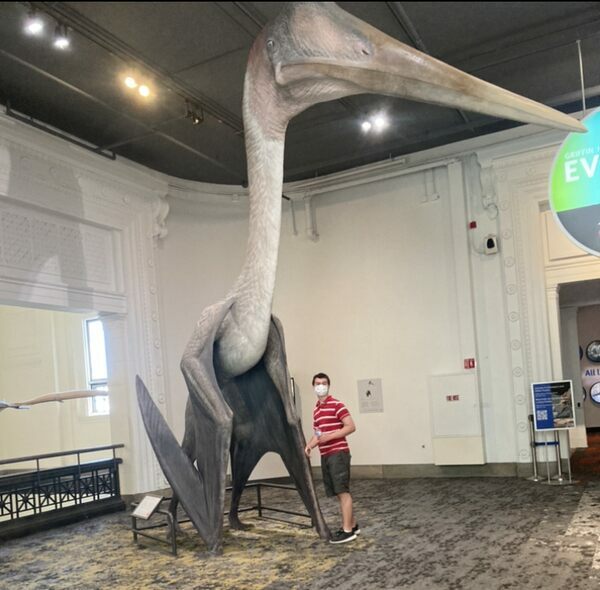
.jpg)
